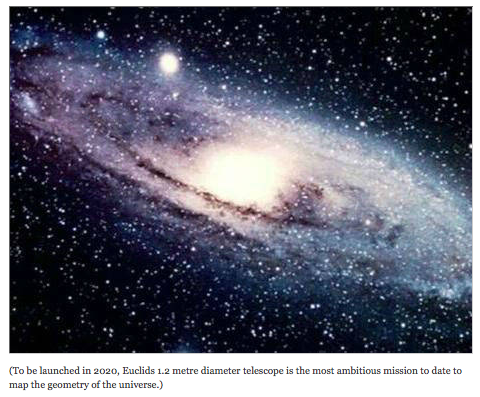Designed to study the enigmatic dark matter and dark energy with great precision, the European mission is due for launch in 2020. Thales is responsible for the satellite and infrastructure and overseeing the integration of all the parts into one system. They are also responsible for launch. “We are proud to be a part of Euclid,” commented Dr Chris Castelli, Acting Director of Technology, Science and Exploration for the UK Space Agency, which will provide millions of pounds of funding to build key parts of the Euclid hardware and software. “Our investment ensures UK companies and scientists can play a leading role in this exciting European mission.”

To map the distribution and evolution of dark energy and dark matter in the Universe, Euclid requires crisp deep images with sharpness similar to that obtained with the Hubble Space Telescope, but over a huge area, some 40 percent of the sky. It will make high precision measurements of billions of distant galaxies, using a technique called ‘gravitational lensing’. The mission will effectively look back in time about 10 billion years, covering the period over which dark energy seems to have accelerated the expansion of the Universe.
The eight UK institutions working on the mission have been granted a planned £8.5 million by the UK Space Agency to develop some of the instruments vital for its mapping task and to support the initial development of the necessary data processing capabilities. UCL’s Mullard Space Science Laboratory is leading the development of the visible imaging instrument (VIS) and the Open University is receiving a grant to carry out the radiation testing and verification. A key Science Data Centre will be hosted by the UK in Edinburgh.
Professor Mark Cropper at Mullard Space Science Laboratory, University College London, said, “The UK is leading the design and construction of the main camera for Euclid. The camera will have 600 megapixels and will be built in the UK with custom-made UK detectors from e2v in Chelmsford. It will also be one of the largest digital cameras ever launched into space and will provide a fabulous view of much of the sky in incredible detail for everyone.”
Euclid’s infra-red camera will be used to measure distances to many of the galaxies seen by the Visible Imager. “These distances give us another view of the dark Universe,” explains Professor Carlton Baugh at the University of Durham who is responsible for generating detailed Euclid simulations. “Looking at a 3-D picture of the Universe is a lot more interesting.”
__________

